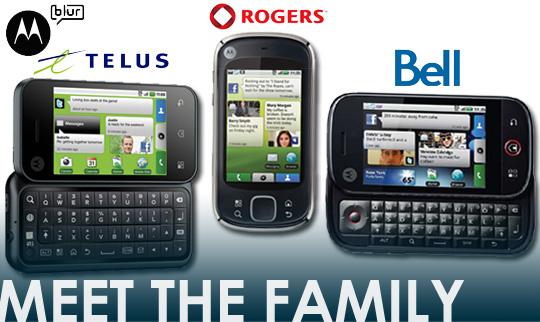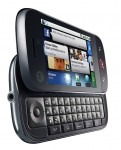MOTOBLUR phones come to Canada on Telus, Bell, and Rogers

The last in the trio of Motorola Android phones running their custom UI, MOTOBLUR, launched in Canada on Tuesday, with the release of the Motorola QUENCH on Rogers. The two other phones in the Motoblur line-up are the DEXT on Bell, and the BACKFLIP on Telus.
The QUENCH is available now for $49.99 ($424.99 outright) on a three-year voice and data plan. It is a touch-screen only device, and has a 3.1” 320×480 screen, 5.0 MP camera, and uses Android OS 1.5, with the MOTOBLUR UI. To make up for the lack of a physical keyboard, the QUENCH includes the Swype software keyboard that speeds up text entry by allowing you to enter text in one continuous motion. It is also part of the Rogers Social View phone line-up, and can use one of their social networking plans that include unlimited access to social networking sites like Facebook, MySpace and Twitter (with a catch, which I plan to detail in a future post).
The DEXT was launched on Friday, May 14th on Bell, and is available for $79.95 ($399.95 outright) on a three-year voice and data plan. It has similar specs to the QUENCH, with the same 3.1 screen, 5.0 MP camera and OS 1.5, but it also has a slide-out physical keyboard and includes Bell’s TV & Radio app, that delivers live TV and commercial-free radio services. We currently have a DEXT on loan from Motorola that we are testing, so expect some hands-on feedback from us, and a full review, soon.
The Motorola BACKFLIP was launched on April 28th, on Telus, and is available for $79.99 ($399.99 outright), down from the original $99.99, on a three-year voice and data plan. Telus was given the honour of being the first Canadian carrier to launch a MOTOBLUR handset with the BACKFLIP, and it complements the higher-end Motorola Milestone that they exclusively carry. The BACKFLIP has the most unique form factor of the three phones — it, too, has a physical keyboard, but unlike the traditional slide-out version on the DEXT, the BACKFLIP has a reverse-flip keyboard, that, when not in use, folds up behind the phone. In addition, when the keyboard is flipped down, the back of the screen becomes a giant touch pad for navigating the UI. In all other respects, though, its specs are the same as the QUENCH and DEXT, 3.1” screen, 5.0 MP camera and Android OS 1.5.
All three phones run MOTOBLUR, which is Motorola’s UI that sits over top of the stock Android OS 1.5. One complaint that is often leveled at vanilla Android, especially 1.5, is that the UI is fairly bland, and there is not much additional functionality, other than standard web-browsing, messaging, and making calls, in the core OS. To address that, HTC was the first to come out with their Sense UI for Android on their HTC Hero phone (reviewed by us here), and Motorola followed by introducing their MOTOBLUR UI when the Motorola Cliq came out in the US, on T-Mobile, last fall.
Motoblur goes a few steps further than Sense, with a home screen widget and application that continuously aggregates all your communication data from sources such as Facebook, Twitter, MySpace, Gmail and Exchange. This data also syncs to the cloud on Motorola’s online ‘owner’s portal’, so data can be restored directly to the phone if it is corrupted, or to a new phone if the original is lost or stolen — and the online portal allows you to track a lost phone by aGPS, and do a remote wipe of personal data. While MOTOBLUR is built on the older 1.5 OS, it does go a long way by adding some of the features that were missing from the user experience in OS 1.5.
As Android continues to evolve in the marketplace, the division between minimally spec’ed smartphones like the QUENCH and the high end devices such as the Sony Ericcson X10, and the Motorola Milestone, is becoming clearer, both in price and power. Although there have been legitimate concerns that Android is becoming a fragmented market, much like Windows Mobile did in the past, this hasn’t stopped Android.
Since the last half of 2009, Android has climbed from 6th place to 2nd place, only behind RIM’s Blackberry OS, based on quarterly sales, and was the only OS to gain in the US during the first quarter of 2010. The US numbers are probably comparable to Canadian sales, though RIM historically has done better here than south of the border.
With the release of these three phones, I am sure Android’s market share will improve further — having such a wide variety of price points and form factors can only help Android become the dominate Mobile OS. What is less clear is how successful MOTOBLUR will be. Running on such an old version of the OS is a liability, and it will be interesting to see if Motorola upgrades the UI to work with Android 2.1 or 2.2, and if they will use it on their next generation of phones coming in the fall.








98548 244843It can be difficult to write about this subject. I think you did an excellent job though! Thanks for this! 699465
973191 56169Its hard to uncover knowledgeable folks on this subject nonetheless you sound like you know what youre talking about! Thanks 747476
297888 620003Awesome material you fellas got these. I truly like the theme for the site along with how you organized a person who. Its a marvelous job For certain i will come back and look at you out sometime. 575743
333774 828056An really intriguing examine, I might not agree completely, but you do make some very legitimate factors. 429413